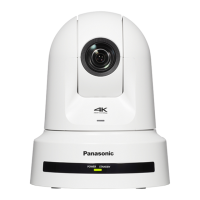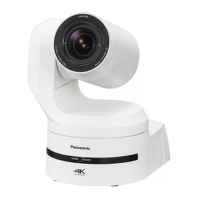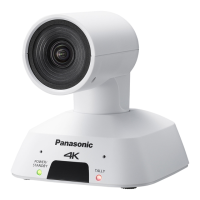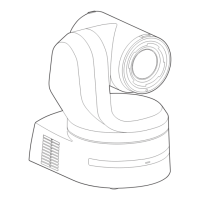Do you have a question about the Panasonic AW-UE50WP and is the answer not in the manual?
Product type and resolution.
Important safety and operational guidelines before initial use.
Declaration of conformity with FCC rules for US operation.
Compliance notification for Canadian operation.
Essential safety precautions when handling the AC power cord.
Step-by-step guide for replacing the fuse in the mains plug.
Guidelines for achieving EMC compliance and managing interference.
Instructions for environmentally sound disposal of electronic products.
Instructions for properly grounding the unit via the SIGNAL GND connector.
List of registered trademarks and copyright information for the software.
General description of the product's features and compatibility.
Specifies the necessary hardware and software for operating the unit.
Identifies potential security risks when connecting the unit to a network.
Panasonic's liability limitations for product use and damage.
Details on supported video formats, sensor, and zoom capabilities.
Highlights ease of use, pan-tilt head, O.I.S., and IP control features.
Explains how PoE+ eliminates the need for separate camera power configurations.
Lists all accessories provided with the unit and optional accessories.
Guidelines on proper handling, environment, and avoiding strong lights.
Notes on automatic functions, zooming, focusing, and HDMI compatibility.
Instructions on power handling, cable connections, and unit storage when not in use.
Guidelines for safely transporting and moving the camera unit.
Advises on selecting a stable installation location to prevent performance issues.
Details on the open-source software licenses used in the product.
Explains how to use the wireless remote, including range and signal reception areas.
Discusses how lighting conditions can impact wireless remote control performance.
Identifies and describes key components of the camera unit, including lamps and connectors.
Details the pan/tilt head mechanism and the function of the tally lamp.
Explains the function of service switches for initialization procedures.
Details the DC IN, RS-422, AUDIO IN, and Ground connectors and their uses.
Describes the LAN, 3G SDI OUT, USB, and HDMI connectors and their functions.
Details tripod screw holes and grounding connection points.
Lists the supported output conditions for the AW-UE50 model.
Lists the supported output conditions for the AW-UE40 model.
Details output conditions for H.265 streaming modes, including resolution and frame rate.
Specifies output conditions for SRT(H.265) streaming, noting limitations.
Outlines output conditions for H.264 streaming, covering various resolutions and frame rates.
Details limitations and output conditions for SRT(H.264) streaming.
Specifies output conditions for RTMP streaming, including resolutions and frame rates.
Details output conditions for MPEG2-TS over UDP streaming.
Outlines NDI|HX V2 streaming settings, including resolution and frame rate.
Describes USB streaming capabilities, including resolution and frame rate limitations.
Explains the purpose and operation of each button on the wireless remote control.
Details the function of focus, zoom, and iris controls on the remote.
Explains speed adjustment and auto controls for focus and iris on the remote.
Guides on setting wireless remote control IDs (CAM1-CAM4) for unit selection.
Explains how to set the installation method (Desktop/Hanging) via the OSD menu.
Instructions for using Easy IP Setup Software to configure network settings.
Information on using EasyIP Setup Tool Plus for network settings and firmware updates.
Procedure for setting up the initial user name and password for network access.
Confirms the completion of the initial account registration process.
Guide for installing the ActiveX plug-in viewer software for IP image viewing.
Outlines the sequence of steps for performing basic shooting operations.
Instructions for powering the unit on and off using the wireless remote control.
Details on how to turn the unit on and off when using a Panasonic controller.
Explains how to select a specific unit using the wireless remote control's CAMERA buttons.
Guides on unit selection when using a controller, including initial account requirements.
Describes the different shooting modes (Full Auto, Scene1-3) and their characteristics.
Step-by-step instructions for selecting a shooting mode using the wireless remote control.
Details how to pan, tilt, zoom, and control camera direction using remote or controller.
Explains how to adjust the speed of camera movement and zoom operations.
Provides solutions for common problems encountered when operating with the wireless remote control.
Offers solutions for issues encountered when operating with a connected controller.
Introduces manual shooting controls and the use of preset memories for storing settings.
Covers white balance, black balance, and black level adjustments for accurate color reproduction.
Explains how to manually adjust focus and iris for precise image control.
Details how to manually set shutter speed and adjust gain for optimal exposure.
Step-by-step guide for saving and retrieving camera settings using preset memories.
Information on managing preset memories when using a controller.
Instructions for performing automatic white balance adjustments using AWB A or AWB B memory.
Explains the ATW function for continuous, automatic white balance adjustment.
Describes the use of 3200K/5600K presets and the VAR setting for manual color temperature.
Details the procedure for automatically adjusting black balance using the ABB function.
Explains how to adjust the black level (master pedestal) for multi-camera synchronization.
Guides on basic operations like displaying menus, selecting items, and changing settings via wireless remote.
Introduces the main menu categories: Camera, System, Output, Pan/Tilt, Preset, and Maintenance.
Explains selecting shooting scenes and adjusting image brightness, including iris and shutter settings.
Details shutter modes, step/synchro speeds, and gain adjustments for exposure control.
Covers Frame Mix, Backlight/Spotlight Compensation, and Flicker Suppression.
Details settings like Auto F.Mix Max Gain, Back Light/Spot Light COMP, and Flicker Suppression.
Explains selecting white balance modes and adjusting color temperature.
Covers ATW speed/target adjustments and chroma level/phase settings.
Details settings for image detail, skin detail smoothing, and related effects.
Explains Gamma modes, Dynamic Range Stretcher (DRS), and Knee controls for image processing.
Details White Clip settings and Digital Noise Reduction (DNR) for image quality.
Covers selection of matrix types (Normal, Pro, User) and adaptive matrix function.
Details how to adjust linear matrix parameters for color correction when User type is selected.
Explains saturation and hue adjustments for specific color ranges in Color Correction 1/3 and 2/3.
Details final color correction settings and essential lens adjustments like focus and zoom.
Covers digital zoom capabilities, digital extender, and optical image stabilization (O.I.S.) modes.
Explains how to enable or disable the optical image stabilization function.
Details system settings including frequency, format, wireless control, USB, and output configurations.
Covers USB mode, auto active, and auto standby settings for USB connectivity.
Provides instructions on how to change the camera's system frequency and the confirmation process.
Step-by-step guide for changing the camera's video format and confirmation screens.
Details format and output level settings for the 3G SDI connector on the AW-UE50.
Explains how to set the output format for the HDMI connector based on system format.
Details settings for color bars, test tones, and audio input/output levels.
Covers OSD Mix, OSD Off with R-Tally, and OSD Status settings for on-screen displays.
Details settings for Tally function, LED limits, and brightness for visual indicators.
Explains settings for status lamps and external output signals via RS-422.
Details installation position, speed modes, zoom-linked speed, focus adjust, privacy mode, and power-on positions.
Covers settings for initial camera positions on power-on and numbering presets.
Details preset speed configurations, scope modes, and digital extender settings.
Explains how to manage preset thumbnails and names (reset/hold).
Details how preset memory affects iris, shutter, and zoom operations.
Overview of maintenance functions: System log, Product info, Default reset, and Backup.
Shows how to check system and software versions for CPU, Camera, Lens, and Servo.
Displays EEPROM and FPGA firmware versions for Main/Network and AVIO components.
Details how to set the IP Address, Subnet Mask, and Default Gateway for network connectivity.
Instructions for copying scene data between different shooting modes (Full Auto, Scene1-3).
Explains how to initialize unit settings to factory defaults for All, Scene All, or individual scenes.
Describes the process and confirmation screens for initializing camera settings.
Shows how to view the unit's cumulative operation time via the Hour Meter.
Provides information on HDMI connection status, format, video sampling, and monitor status.
Details error status for lens, pan/tilt, and temperature sensors, including possible causes.
Compares factory settings with selection items for Scene and Brightness menu parameters.
Summarizes factory and selectable options for Picture menu items like White Balance, Chroma, and Detail.
Compares factory and selectable items for Matrix types, Linear Matrix, and Color Correction settings.
Summarizes lens settings including focus mode, AF sensitivity, zoom options, digital extender, and O.I.S.
Details frequency, format, wireless control, and USB settings for the System menu.
Summarizes output settings for 3G SDI and HDMI connectors, including supported formats.
Covers settings for Bar, Tone, Audio, OSD Mix, Tally, and External Output options.
Summarizes Pan/Tilt installation position, speed modes, and zoom position settings.
Compares factory and selectable items for preset speed, scope, digital extender, and iris/shutter.
Summarizes maintenance items like firmware, IP network, scene copy, initialization, and logs.
Guide on accessing the unit's web interface using a personal computer and browser.
Instructions for entering the unit's IP address into the web browser's address bar.
Steps for setting the initial user name and password for web interface access.
Details on how to access and view the live camera screen after initial setup.
Explains how to toggle between the live camera view and the web setup interface.
Details the login process for accessing web interface screens with user authentication.
Introduces the live screen layout and controls for H.264 and JPEG streams.
Describes the availability and function of touch panel and expansion panel display buttons.
Explains how to switch between stream menus and select compression types (H.264/JPEG).
Details operations for the OSD menu and controls for displaying color bars.
Explains how to control power and lock operations via the web interface.
Describes the main area for IP video display, including tally lamp indicators and interactive movement.
Explains how to use zoom controls (T/W, D-Zoom, D-Ext) and focus controls (Far/Near, Auto, O.T.AF, Touch AF).
Details iris adjustment, speed control, preset operations, and use of the control pad.
Details how to select scenes, adjust gain, white balance, and shutter settings via the web interface.
Explains functions of streaming buttons, snapshot, PC screen switch, thumbnail list, real-time update, and audio level meter.
Outlines the main sections of the web setup screen: Setting status, Basic, Image, Collaboration, User management, Network, and Maintenance.
Explains user authentication, host authentication, and network setup options.
Covers system logs, product info, reset settings, backup, and power control setup.
Displays system status for frequency, format, wireless control, USB, and output settings.
Guides on setting the system frequency and selecting the video format for the camera.
Details settings for wireless control IDs and USB connection modes (Auto Active/Standby).
Covers the configuration of 3G SDI and HDMI output settings, including format options.
Explains format and output level settings for the 3G SDI connector on AW-UE50.
Details the available format options for HDMI output based on system format.
Details settings for color bars, test tones, OSD mix, and OSD status indicators.
Covers Tally lamp settings, brightness, status lamp, and external output configurations.
Details installation position, pan/tilt speed modes, and zoom-linked speed settings.
Explains focus adjustment with PTZ, privacy mode, and power-on position settings.
Guides on setting date and time using PC Sync, NTP, or Manual methods, including memory settings.
Details camera title input, automatic viewer installation, and smoother video display settings for the live page.
Introduces IP video settings, including streaming mode and initial display settings.
Explains how to select streaming modes (H.264, H.265, RTMP, SRT, NDI|HX, UDP, USB) for IP transmission.
Covers initial display settings and JPEG transmission options like capture size and refresh interval.
Details JPEG image quality settings and refresh interval options based on system frequency.
Explains H.264 transmission, internet mode, profile type, and capture size settings.
Details transmission priority, frame rate, max bit rate, and image quality settings for H.264.
Covers H.264 frame rate, max bit rate, image quality, and transmission types.
Details Unicast port, Multicast address, and TTL/HOPLimit settings for transmission.
Explains H.265 transmission, image capture size, frame rate, and max bit rate settings.
Details transmission types for H.265, mirroring H.264 settings.
Guides on setting up RTMP servers, URL types, stream keys, and streaming formats.
Covers SRT transmission settings including mode, destination, and common setup parameters.
Details SRT stream ID, client port, TTL/HOP limit, group, and discovery server settings.
Explains how to configure MPEG2-TS over UDP transmission types (Unicast/Multicast).
Covers Unicast/Multicast addresses, ports, TTL, Push UDP, and streaming formats for MPEG2-TS.
Guides on NDI|HX V2 settings including source name, protocol, multicast transmit, and address.
Details NDI|HX V2 subnet, TTL, group, name, discovery server, and streaming format.
Covers audio input settings, volume levels, plugin power, and input type (Mic/Line).
Explains audio transmission settings, including audio over IP and audio bit rate.
Introduces the Image Adjust screen for scene selection, scene copying, and camera control access.
Details Picture Level, Iris Mode, Auto Iris Speed, Window, and Iris Limit settings.
Explains Shutter Mode options (Off, Step, Synchro, ELC) and ELC Limit settings.
Provides detailed shutter speed options and gain adjustment settings, including Super Gain.
Covers Frame Mix, Auto F.Mix Max Gain, Backlight/Spotlight Compensation, and Flicker Suppression.
Details white balance modes (ATW, AWB, 3200K, 5600K, VAR) and color temperature settings.
Explains R Gain, B Gain adjustments, AWB Color Temp Info, and AWB Gain Offset settings.
Covers ATW speed/target, chroma level/phase, ABB, and master pedestal adjustments.
Details settings for image detail, gamma, DRS, knee mode, white clip, and DNR.
Explains DNR settings and selecting Matrix types (Normal, Professional, User).
Details linear matrix adjustments and color correction parameters when User matrix type is selected.
Details matrix type selection and adaptive matrix settings.
Covers lens focus modes, AF sensitivity, zoom options, digital extender, and O.I.S. mode.
Explains settings for the digital extender function and optical image stabilization modes.
Describes how to set and manage preset camera positions on the web interface.
Details preset speed configurations, scope modes, and digital extender functions.
Covers setting pan/tilt movement range limits and PTZ lens control functions.
Covers configuration of preset speed, scope modes, and digital extender functions.
Details options for preset thumbnail updates, naming, iris reproduction, and shutter settings.
Explains user authentication settings, modes, and host authentication configurations.
Details how to set up a connection to P2 Cast, including mode, cloud URL, user ID, and password.
Covers procedures for adding new users and deleting existing user accounts.
Details host authentication settings, including IP address restrictions and mode selection.
Provides comprehensive settings for IPv4 and IPv6 networks, including DHCP, IP addresses, and DNS.
Covers common network settings like HTTP port, RTP packet size, and host management.
Explains DHCP, IP address, subnet mask, and default gateway settings for IPv4 networks.
Details IPv6 network configuration, including manual/DHCP settings and DNS server setup.
Covers HTTP port range, max RTP packet size, and HTTP max segment size configurations.
Details Easy IP Setup accommodate period and how to check active network settings.
Provides recommended network settings for optimal internet connectivity.
Explains how to check the active network settings (IPv4, IPv6, DNS) enabled on the unit.
Details HTTP/HTTPS port numbers and status, along with router global address.
Guides on configuring NTP server settings, address, port, and time synchronization.
Explains how to use UPnP for automatic port forwarding and its settings.
Introduces HTTPS for encrypted access, covering CRT key generation and certificate management.
Details the process of installing server certificates for secure HTTPS access.
Covers setting connection methods (HTTP/HTTPS) and port for accessing the camera securely.
Explains SNMP settings for unit status monitoring, including user name, authentication, and encryption.
Details how to set up RTSP request URLs for IP image transmission.
Covers SNMP password, system name, location, and contact information settings.
Details TSL5.0 protocol settings for tally control and referrer check for access security.
Explains how to set the mDNS host name for accessing the unit via hostname.local.
Details 802.1X client settings, EAP methods, TLS authentication, and certificate installation.
Covers PEAP user name, password, and CA certificate installation for authentication.
Explains the plain text usage setting for encrypting communications with Easy IP Setup Tool Plus.
Outlines the process for generating CRT keys, self-signed certificates, and CSRs for HTTPS.
Explains the overall process flow for accessing the camera securely using HTTPS.
Step-by-step guide for generating CRT keys, including key size selection and history management.
Details the process for generating a self-signed certificate, including inputting certificate information.
Explains how to generate a CSR, input certificate details, and save the request file.
Guides on installing server certificates from a CA for secure HTTPS connections.
Details how to set the connection method (HTTP/HTTPS) and port for accessing the camera.
Step-by-step instructions for installing the security certificate to avoid warning screens.
Details the final steps of the certificate import wizard, including placing certificates and confirming success.
Explains the system log structure, including event logs and error logs storage capacity.
Details the information captured in event logs (date, time, code, description) and error logs (date, time, code, description).
Details how to check model, MAC, serial, firmware versions, and EEPROM/FPGA info.
Covers firmware upgrading, operation time, viewer counter, OSS license, and activation status.
Step-by-step guide for downloading and upgrading the unit's firmware.
Explains how to reset unit settings to default and reboot the system.
Instructions for downloading unit configuration data (settings, scenes, network) to a personal computer.
Details the process of uploading saved configuration files from a PC back to the unit.
Describes buttons for accessing PTZ, Preset, and Image Adjust screens on touch panel interfaces.
Details the layout of PTZ, streaming, and snapshot operation areas optimized for touch panels.
Explains the touch-optimized areas for preset operations and image adjustments like iris, gain, and shutter.
Covers how to interact with the setup menu using touch panel controls.
Instructions for accessing the unit's web interface from mobile terminals using an IP address.
Describes switching between Camera Control, Full Screen, and Touch Operation Select modes on mobile devices.
Details the operation menu for the live screen on mobile terminals, including power, compression, streaming, and zoom controls.
Explains PTZ/Focus operation areas, Home button, and switching between controls on mobile interfaces.
Guides on connecting and using the unit as a web camera via USB, outlining supported functions.
Details image adjustments like brightness, hue, saturation, sharpness, and gamma for web camera use.
Details manual controls for zoom, focus, exposure (shutter speed), and iris/aperture.
Covers camera pan/tilt movements and audio input mixer settings for web camera use.
Explains the function of limiters to restrict panning and tilting movement ranges to prevent obstacles.
Outlines the basic steps for setting and releasing movement range limiters using the remote control.
Provides detailed steps for setting, releasing, and resetting upper, lower, left, and right movement limiters.
Explains when the unit enters safe mode and its effect on operations to prevent damage.
Describes how the unit detects trouble, shuts down functions, and restarts to restore normal operation.
Addresses issues related to power, general operability, and remote/controller operation.
Solves problems with incorrect unit direction or improper unit selection for operation.
Covers problems with LAN cable connection, power status, and IP address validity for web access.
Addresses issues with HTTP vs HTTPS, IP address conflicts, subnet masks, proxy settings, and gateways.
Solves issues with web screen updates, file downloads, and temporary internet file management.
Addresses problems with tally lamps, status lamps, repeated authentication, slow screen display, and multiple user access.
Solves issues with no pictures, flipped images, color bands, menu visibility, and auto-focus problems.
Addresses focus problems, jerky video, coloring issues, and brightness problems.
Solves problems with distorted subjects, flash effects, brightness/color changes, flicker, and audio noise.
Addresses issues with IP images not displaying, appearing blurry, or not updating.
Solves problems with H.264 image display, distortion, and multiple browser display sequences.
Addresses IP image update problems and audio output issues with NDI|HX compatible switchers.
Solves frame dropping in images and addresses information bar messages in Internet Explorer.
Addresses issues with status bars, IP image frame mismatches, distorted layouts, and non-operating buttons.
Details power requirements, environmental conditions, mass, dimensions, finish, and connector types.
Lists specs for imaging sensors, lens, zoom, angle of view, focus, illumination, resolution, gain, and frame mix.
Details electronic shutter speeds, synchro scan, white balance, gamma, scene files, and output formats.
Covers pan/tilt operation speed, ranges, quietness, IP/AW cable specs, and AC adapter details.
| Brand | Panasonic |
|---|---|
| Model | AW-UE50WP |
| Category | Digital Camera |
| Language | English |












